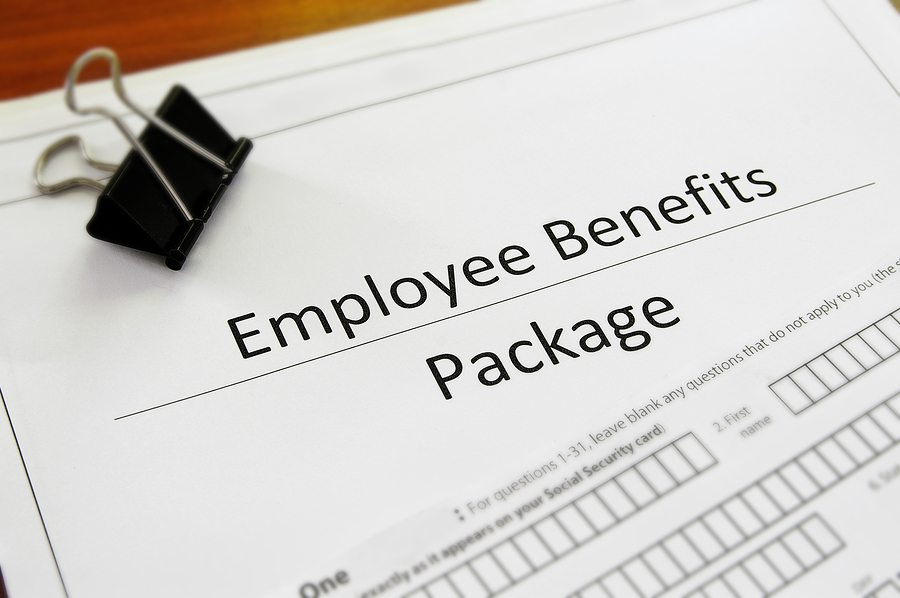by jeffp | May 11, 2016 | Employee Benefits

Each year the Equal Employment Opportunity Commission (EEOC) collects data on the race, ethnicity, sex and job category of private sector employees. The data is then provided to the Office of Federal Contract Compliance Programs (OFCCP) at the Department of Labor.Employers with 100 or more employees—or those with fewer than 100 if the company is owned or affiliated with another company for a total of 100 or more employees—submit the data to the EEOC using Standard Form 100, also known as EEO-1. Federal contractors with 50 or more employees are also required to report employment data to the EEOC.
This year, the EEOC proposed changes to the data it collects. Officially published in the Federal Register on February 1, 2016, the changes include adding data on employees’ pay ranges and hours worked. The new data will assist the EEOC in its efforts to identify pay discrimination and assist employers with providing equal pay in their workplaces. Members of the public haduntil April 1, 2016, to submit comments on the proposed changes. Should the EEOC elect to move forward with their proposal, the additional data will be required beginning in September 2017.
“More than 50 years after pay discrimination became illegal it remains a persistent problem for too many Americans,” EEOC Chair Jenny R. Yang said in a January press release. “Collecting pay data is a significant step forward in addressing discriminatory pay practices. This information will assist employers in evaluating their pay practices to prevent pay discrimination and strengthen enforcement of our federal anti-discrimination laws.”
Many employers have expressed concerns about the EEOC’s proposed changes. Some believe that the additional data reporting requirements will create an unnecessary and significant administrative burden for employers. Others don’t feel that the changes will be useful, as they say the EEOC has failed to address how they will account for a variety factors that impact individual pay such as performance, education and seniority.
While U.S. laws require equal pay for equal work, many women earn less than men when doing the same job. The gender pay gap has narrowed since the 1980s, when women only made 60 cents to every male dollar earned, but it’s still there. The latest figures, from 2015, show women making 80 cents to the dollar.
The pay gap is higher in some industries. A recent survey by Glassdoor found that female dentists, physicians, psychologists, pharmacists, medical technicians and opticians are often paid 14 to 28 percent less than their male colleagues. Female social workers, communications associates, social media representatives and research associates earn—on average—marginally more than males in the same role.
by jeffp | Apr 5, 2016 | Employee Benefits

Life expectancy is increasing, Social Security benefits are shrinking, and a recent study shows that 54 percent of Americans have too little saved to ensure an adequate income stream after they collect their last paycheck. Given these facts, you’d expect more of your workers’ New Year’s resolutions to focus on retirement—but that’s not the case.
According to the New Year’s Resolutions Survey from Allianz Life Insurance Company, 44 percent of respondents plan to put their focus on health and wellness this year. Only 29 percent were pledging to improve their financial security in 2016, followed by 13 percent who were going to make changes to their career or employment and 9 percent who were determined to enhance their education.
If you’re not currently offering benefits to help your employees meet this highly popular goal, you may want to do so as soon as possible. According to the Society for Human Resource Management’s (SHRM) Strategic Benefits Survey, 69 percent of companies offer some type of wellness program, resource or service to their workers. Among them, 40 percent increased their investment in employee wellness initiatives in 2015.
Their employees responded favorably; 52 percent reported that employee participation in wellness initiatives had increased over the prior year, in part due to the incentives or rewards they offered including:
- Reduced healthcare premiums (45 percent)
- Gift cards (37 percent)
- Company gift items (25 percent)
- Recognition (20 percent)
- Time off from work (7 percent)
- Bonus or cash (7 percent)
- Contributions to HSA/HRA (3 percent)
Assisting your employees with their health-related resolutions (such as to exercise more, lose weight or lower their blood pressure) can help you attract better job candidates and retain your best workers. Twenty-four percent of employee participants in the SHRM survey said workplace wellness programs were a “very important” contributor to job satisfaction.
But that’s not all; wellness initiatives are also good for your bottom line. Seventy-seven percent of employers said the initiatives had been “somewhat” or “very effective” in decreasing their company’s cost of healthcare. Eighty-two percent said the initiatives were “very effective” or “somewhat” effective in improving the physical health of their company’s workers—an important factor in productivity.
If you need a few suggestions to integrate into your own workplace wellness initiative, consider the following—some of which won’t cost you a dime:
- Walking meetings
- Onsite fitness classes
- Onsite preventative screenings
- Onsite fitness and weight loss tracking
- Departmental and interdepartmental weight loss competitions
- Walking or “Steps per Day” challenges
- Reimbursement for gym membership
- Stress management assistance
- Goal-setting assistance
- Support groups
- Healthy vending machine alternatives
- Mandatory vacation
- Group participation in community running and cycling events
If you’re ready to get started with a workplace wellness program, we can help. Contact us for further suggestions, currently available benefits and more.
by jeffp | Mar 22, 2016 | Employee Benefits

The number of women working in American businesses is continually increasing. According to data from the Bureau of Labor Statistics (BLS), the U.S. workforce was only 38 percent female in 1970. The most recent numbers show women now make up 47 percent. Whatever your company’s industry, they likely account for a sizable portion of your staff as well. And while keeping all of your employees engaged in their jobs is necessary to reduce costly turnover, retaining your female workers may require slightly different tactics.
To start, more money isn’t usually the answer. Glassdoor’s currentU.S. Employment Confidence Survey results reveal that 82 percent of female employees would prefer additional benefits or perks over a pay increase (compared to 76 percent of the male workers).When asked to rank the benefits they’d prefer to see increased, healthcare insurance, vacation/paid time off, performance bonuses, paid sick days, retirement plans and flexible schedules topped the list.
Somewhat surprisingly, childcare assistance and paid parental leave ranked much lower than the rest of the options, with only 13 percent of the surveyed employees preferring additional benefits of that type.
Of course, the Glassdoor survey isn’t the final word in what your female workforce wants. Your best bet to ensure you’re offering the benefits they find most desirable it to ask. You can then use this information to fine tune your benefits package, creating the best possible combination of offerings within your budget to both attract and retain the experienced professionals—both male and female—your business needs.
Here are a few considerations generally noted as important to women workers:
- Flexible Schedules – Today’s professionals—both male and female—value schedule flexibility. From alternative work schedules (such as four 10-hour shifts a week) and telecommuting to flextime (which allows workers to set their own hours), providing schedule flexibility is the simplest way to help your workers achieve work-life balance.Depending on your industry, if you want to remain competitive in retaining and attracting top talent, you cannot afford not to explore ways to give your workers more flexibility in their schedules. Doing so will also help you decrease absenteeism, increase productivity, reduce employee stress and build trust.
- Family-Friendly Perks – For the last 30 years, Working Mother has ranked the nation’s top 100 companies for women with families. In 2015, women made up 46 percent of the workforce at the 100 companies selected, filling 43 percent of the management jobs and accounting for 26 percent of the companies’ executives. How do these organizations attract and retain so many top-notch female workers? In part, they offer family-friendly benefits such as:
- Full paid maternity leave (100 percent)
- Paid adoption leave (93 percent)
- Paid paternity leave (90 percent)
- Childcare resource and referral service (96 percent)
- Telecommuting (100 percent)
- Flextime (100 percent)
- Elder care referral service (99 percent)
- Travel planning services (84 percent)
- Dry cleaning services (64 percent)
- On-site flu vaccinations (96 percent)
- On-site fitness center (88 percent)
- On-site massage therapy (65 percent)
Are you finding it difficult to attract qualified job candidates and retain your best employees? Your benefits package could be the problem. Contact us today for a plan review and upgrade or enhancement suggestions.
by jeffp | Jan 25, 2016 | Employee Benefits

A successful business and a competitive employee benefits package go hand in hand; you’ll rarely find one without the other. Not only do generous perks attract more job candidates to your company, they also help you minimize employee turnover, improve morale and increase productivity. But don’t stop at paid time off and a 401(k) plan. Consider these voluntary employee benefits you should add today.
Critical Illness/Cancer Insurance – Supplemental critical illness and cancer policies are becoming increasingly popular with American workers. A Hartford study found that Generation Y workers participate in these programs at a higher rate, so they may be a particularly attractive addition to your benefits package if you’re recruiting or employing younger workers.
Accident Insurance – With the cost of health insurance under the Affordable Care Act driving many consumers to bronze plans with higher deductibles and out of pocket expenses, accident insurance offers your employees welcome peace of mind should they break a leg skiing or suffer an injury-causing fall at home.
Hospital Indemnity Insurance – If you have a lot of employees with high-deductible bronze-level health insurance coverage, hospital indemnity insurance will help them pay any hospital-related expenses their regular plan does not cover. This can significantly reduce their out of pocket costs for hospital stays, outpatient services and tests such as MRIs and CT scans traditionally performed at hospitals.
Integrated Long-Term Care and Life Insurance – As some carriers have stopped offering standalone long-term care products, others have begun to bundle long-term care and life insurance into one attractive package. The long-term care benefits, which your employees can use for future long-term care, home health care, assisted-living care and adult daycare, are usually bundled with a universal life policy.
Life Insurance and Disability – One third of U.S. households don’t have an individual life insurance policy or have a life insurance gap. Employers who offer their workers a supplement life and disability plan have the opportunity to make a real impact on their financial wellbeing.
Dental and Vision – When employers cut back on benefits during the economic downturn, many eliminated the supplemental dental and vision plans they previously offered their employees. However, as consumers’ out of pocket healthcare costs have continued to increase, their desire for these types of benefits has grown. Regardless of their age, your employees are likely to appreciate the opportunity to purchase this type of supplemental coverage again.
Legal insurance – When an employee suffers a personal problem—such as a home foreclosure, bankruptcy or divorce—it can have a negative effect on his or her productivity at work. Some employers are adding supplemental legal insurance to their benefits package to provide their staff with affordable solutions. Coverage varies by plan but generally includes access to a network of attorneys as well as free educational tools and resources.
The unexpected expense of a critical illness, accident, hospitalization, disability or legal difficulty would financially devastate most employees. In fact, according to the most recent MetLife Employee Benefits Trends Study, only 3 percent of workers report having a three-month’s salary cushion of savings to help them through a tough time. Talk to your benefits advisor about adding a few of these supplement insurance products today.
by jeffp | Jan 12, 2016 | Employee Benefits
 A required minimum distribution, or RMD, is the minimum amount one must withdraw from an IRA or retirement account each year. RMDs typically kick in after the owner of the account turns 70.5, and if your company offers any sort of employer-sponsored retirement plan (including profit-sharing plans, 401(k) plans, 403(b) plans and 457(b) plans) you could face serious consequences if your 70.5 and up workers fail to meet the RMD requirements.
A required minimum distribution, or RMD, is the minimum amount one must withdraw from an IRA or retirement account each year. RMDs typically kick in after the owner of the account turns 70.5, and if your company offers any sort of employer-sponsored retirement plan (including profit-sharing plans, 401(k) plans, 403(b) plans and 457(b) plans) you could face serious consequences if your 70.5 and up workers fail to meet the RMD requirements.
Consider the following employer RMD responsibilities as well as the steps you should take to protect your invested workers and your plan, from alerting participants who are approaching RMD age to activating the fund withdrawal.
Employers are ultimately responsible for RMDs. Although your employee should make an effort to understand the minimum distribution requirements of the employer-sponsored retirement savings plan, making sure RMDs happen is ultimately your responsibility. You should notify participants age 70.5 or older in advance of the filing deadline each year and, if they fail to file for distribution, you should set the process in motion yourself to protect your company’s retirement savings plan.
Employers must educate their employees. Do your employees know that they’ll pay a 50 percent penalty tax on the distribution amount if they fail to take the RMD? In addition, if they fail to file for their RMD, they will need to submit specific forms to the IRS to amend the situation. While penalty waivers are possible, they require a letter detailing the unforeseen circumstances leading to the error.
Employers face penalties, too. If the employer-sponsored retirement plan fails to distribute an RMD, whether that failure is your employee’s fault or your own, the plan may be subject to consequences such as losing tax-qualified status and elimination of your tax deduction for employer contributions. As soon as you realize you’ve missed a distribution, you must contact the IRS and begin the reconciliation process as outlined by the Employee Plans Compliance Resolution System.
You can correct your mistakes. If you miss an RMD, you can correct your mistake using the IRS’s Self-Correction Program without paying a fee—provided you’ve made an “insignificant operational mistake” or a “significant operational mistake” that you are correcting within the required timeframe outlined by the IRS. You may also choose the Voluntary Correction Program if you prefer written IRS approval of your correction, though the VCP does require payment of a fee.
It’s essential you monitor your employee’s RMDs if you want to ensure your employer-sponsored retirement plan maintains its tax-preferred status. Contact your benefits expert for additional insight on retirement plan RMDs or to discuss benefit administration services you may find helpful.
by jeffp | Dec 22, 2015 | Employee Benefits

Retirement concerns are on the minds of many Americans. According to the National Institute on Retirement Security, a non-profit research and education organization that recently conducted a survey on the subject, 83 percent are concerned that current economic conditions will affect their retirement. Additionally, 70 percent believe it is harder to retire today than it was for previous generations—and many are planning to remain in the workforce longer as a result.
While we wouldn’t wish the distress of perceived financial insecurity on anyone, the situation does present an opportunity for employers to leverage benefits including retirement planning education and assistance to their advantage—helping their workers in the process.
Job Seekers Consider Benefits Packages
A survey conducted by Monster.com, an online employment solution, found that most job seekers consider the benefits packages of employers before accepting an employment offer. While it’s not surprising that 32 percent of the respondents ranked a healthcare plan as the most important benefit package component, 8 percent preferred an employer-sponsored retirement plan.
While one might think a retirement plan would hold more attraction for older workers, it is not always the case. According to ADP Research Institute, 66 percent of younger professionals are counting on more help from their employers to achieve financial security through benefits. Only 31 percent of older workers feel the same way.
A survey conducted by ManpowerGroup, an employment firm, found 52 percent of American employers were having difficulty finding suitable talent to fill job openings—even though national unemployment remains high. In an environment where you face considerable competition for the best workers, including retirement planning education, assistance and a 401(k) in your benefits package could increase your chances of landing top candidates.
Benefits Also Impact Employee Retention
Fifty-nine percent of employees say that retirement benefits influence their company loyalty according to ADP Research Institute. It’s easy to see why. Data from the Employee Benefits Research Institute shows that 64 percent of employees enrolled in employer-sponsored retirement plans feel confident in their ability to save enough money to retire comfortably. Only 48 percent of those who do not participate in such a program can say the same.
Consider Worker Preferences When Designing a Retirement Plan Benefit
If you want to get the greatest benefit from an employer-sponsored retirement plan, you need to design it in a way that will attract most of your employees—and these days that means Generation X and Generation Y workers. These professionals value continuous access to educational tools and resources online as well as integration with social media and mobile applications. They are also drawn to newer 401(k) options such as automatic opt-in and target date funds according to ADP.
Whether you already offer retirement planning education and assistance as part of your benefits package or have recently begun considering the merits of such a move, talk with your benefits provider to learn more about creating the optimal win-win situation for your company and your employees.





 A required minimum distribution, or RMD, is the minimum amount one must withdraw from an IRA or retirement account each year. RMDs typically kick in after the owner of the account turns 70.5, and if your company offers any sort of employer-sponsored retirement plan (including profit-sharing plans, 401(k) plans, 403(b) plans and 457(b) plans) you could face serious consequences if your 70.5 and up workers fail to meet the RMD requirements.
A required minimum distribution, or RMD, is the minimum amount one must withdraw from an IRA or retirement account each year. RMDs typically kick in after the owner of the account turns 70.5, and if your company offers any sort of employer-sponsored retirement plan (including profit-sharing plans, 401(k) plans, 403(b) plans and 457(b) plans) you could face serious consequences if your 70.5 and up workers fail to meet the RMD requirements.

